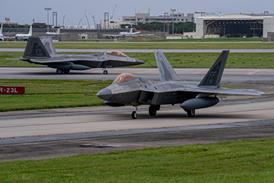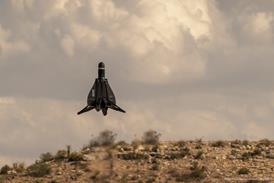Ramon Lopez/NEWPORT NEWS, VIRGINIA

Tomorrow's aircraft carriers are taking shape on the computer screens of US Navy and industry officials in charge of designing and building the final Nimitz-class carrier, the CVN 77, and the future CVNX - the carrier class intended to serve until the end of the 21st century.
Two years ago, the USN abruptly changed course on its future flat-tops. The plan to move from the CVN 68 Nimitz-class to a "clean-sheet" CVNX baseline was deemed unaffordable and risky.
Some observers say the CVNX needs a new design, but Michael Petters, vice-president and general manager, aircraft carriers, for Newport News Shipbuilding, sees the need to "efficiently and cost-effectively evolve the design as we go forward".
A new strategy was developed to evolve to a new CVNX baseline over a series of transitional ships, beginning with the CVN 77. It was also determined that the new nuclear-powered large-deck carriers - equivalent in size to the CVN 68 - should be capable of supporting a 75-aircraft air wing, but the USN is rethinking the make-up of its carrier aviation force.
The USN maintains 12 active carriers and their tactical aviation assets, including 10 active-duty carrier air wings and one reserve wing. It is committed to keeping at least a dozen carriers indefinitely, but a debate is under way on the need for as many as 15.
The nuclear-powered Nimitz-class warships are in the 90,000t displacement category and are almost 335m (1,100ft) long. Each has four steam catapults to launch aircraft and four arresting wires are used to recover them. Each air wing has 70 aircraft, including Grumman F-14 Tomcats, Boeing F/A-18 Hornets, Northrop Grumman E-2C Hawkeye airborne early warning aircraft and helicopters.
NNS, the only US shipyard able to build nuclear-capable carriers, is soon to deliver the $5 billion USS Ronald Reagan (CVN 76) - the ninth Nimitz-class nuclear carrier. It will replace the USS Constellation (CV 64) in 2003.
The CVN 77 will then succeed the USS Kitty Hawk (CV 63) in 2008. Serving as the first step in the phased transition to the CVNX baseline, the CVN 77, which will cost about as much as the CVN 76, will feature no radical changes to the basic Nimitz-class design.
It will, however, incorporate significant improvements, including an integrated combat system, a reduced radar signature island structure with a multifunction, phased-array radar and other flat-plan antennas, and propulsion plant improvements. Petters says the CVN 77's design will be solidified within months.
Systems improvements
This year, NNS chose Lockheed Martin over Raytheon as the warfare systems integrator for the CVN 77. As part of the $500 million, seven-year contract, the company will improve the interoperability among the sensors, communications, aircraft control, armaments and other electronic systems on the ship.
Data sources will be consolidated to provide a clear and coherent tactical picture to all crew members. Automation will reduce crew workload and lower operating costs. The evolution will continue with CVNX 1 which begins construction in 2006 to replace the USS Enterprise in 2013. Although retaining the basic CVN 68 hull and layout, it will have a new nuclear and new electrical plant. NNS expects to start serious design work this year.
A third major upgrade will be the replacement of the steam-powered aircraft catapults with an electromagnetic aircraft launching system (EMALS) capable of launching current and future naval fixed-wing piloted aircraft and unmanned combat air vehicles.
Last December, the USN chose Northrop Grumman and General Atomics from seven bidders to develop EMALS competitively. Northrop Grumman won a $62 million contract, while General Atomics received $60 million to undertake EMALS programme definition and risk reduction efforts.
This phase of the project includes the development and demonstration of full-scale, reduced-length, fully integrated prototypes by the end of 2003.
One EMALS contractor will be selected to undertake engineering and manufacturing development (EMD) and EMALS production. The winning design will undergo extensive land-based operational testing during EMD, which runs between 2004 and 2009. A production award is planned for 2008, with deliveries beginning two years later.
The USN hopes to save about $1 million a year per catapult through reduced maintenance and manning requirements. EMALS will also reduce catapult weight and space requirements by 50% while increasing reliability.
Base configuration
The construction of CVNX 2 - the third evolutionary step - begins in 2011. Its design features will establish the basic configuration for the 10 follow-on carriers of this class. When completed in 2018, CVNX 2 will replace the USS John F Kennedy.
Design changes to this warship will be more apparent. Hull improvements, automated damage control sensors and a new flightdeck design are envisaged, as is the use of an electromagnetic aircraft recovery system (EARS). Like EMALS, EARS would reduce maintenance and manning requirements of current generation arresting systems while enhancing their reliability and performance.
NNS plans to maintain its leadership in the field, having created the Carrier Innovation Center, where technology is evaluated for possible use in CNV 77 and CVNX, several years ago. The Virginia Advanced Shipbuilding and Carrier Integration Center is under construction. Set to begin operations in June next year, the new facility will be the focal point for the integration of systems and the application of emerging technology into future carriers.
Manning for today's Nimitz-class carrier includes 3,500 in the ship's company and 2,200 personnel in an air wing. The USN would like to reduce that by 50% for the CVNX. NNS believes so-called gravity-compensated weapons-handling robotics can be used to arm tactical aircraft. Tests conducted by the shipyard show that 225kg (500lb) weapons can be loaded by one person using a robotically controlled lifting arm. About 8% of the crew handles weapons. Using robotics, one bomb handler could do the work of five.

While deciding to stick with nuclear-powered large-deck aircraft carriers, the USN is considering major changes to carrier aviation. Plans remain in place to populate decks with the Boeing F/A-18E/F Super Hornet strike aircraft and the Joint Strike Fighter. But development of a Common Support Aircraft, designed to replace 250 Lockheed S-3B Viking and ES-3A Shadow, E-2C and C-2 Greyhound aircraft, may be terminated to save up to $20 billion.
The Hawkeye would undergo a further upgrade while the service life of the C-2s would be extended. The Viking could be phased out by 2008 with its anti-submarine and refuelling missions passed on to other fixed-wing and rotary-wing aircraft.
Selection of an Advanced Electronic Attack Aircraft to replace the Northrop Grumman EA-6B remains the subject of an analysis of alternatives (AoA) with the proposed F/A-18G, the so-called Growler, a viable contender. Meanwhile, shrinking the standard air wing from 56 strike aircraft to 50 is being considered. The cost savings might lead to formation of an 11th active-duty carrier air wing.
Having worked under a CVN 77 advanced planning contract since 1998, NNS officials anxiously await the award of a follow-on multi-billion-dollar deal for detailed design and construction of CVN 77, which the USN plans to release this December.
The USN touts the aircraft carrier's ability to establish "littoral battlespace dominance" in regional areas, using forces that have become more expeditionary in nature, but Rear Adm Mark Gemmill, the head of aircraft carrier programmes, says there is not much difference between "blue water" and littoral operation, "which are handled in much the same way".
Gemmill says that aircraft carriers are not "sitting ducks" and he believes that "the aircraft carrier is the most survivable surface ship known to man." So far, it has been smooth sailing for CVNX. Gemmill says: "We're not in trouble, not having technical problems, and we're adequately funded. But there will be issues as wego along, and we will try to contain the overall costs."
Source: Flight International























